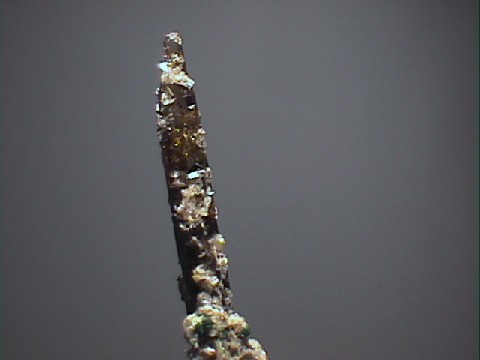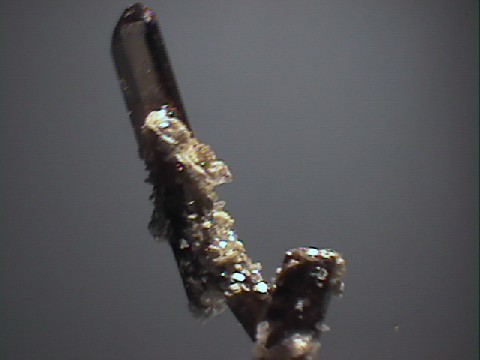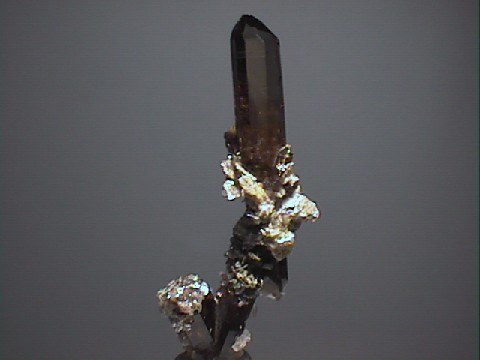 THE MINERAL
THE MINERAL
PYROPHYLLITE
- Chemistry: AlSi2O5OH , Aluminum Silicate Hydroxide.
- Class: Silicates
- Subclass: Phyllosilicates
- Group: The Clays
- Uses: As a refractory mineral, as a filler for rubber, paints and insecticides, as an ornamental stone, as a component of ceramics and as mineral specimens.
Specimens
Pyrophyllite is an early stage metamorphic mineral and is actually quite common although usually not very abundant as good mineral specimens.
It is found as a constituent of slate, phyllite (which is not named after pyrophyllite), some schists and other early stage metamorphic rocks.
It is most common in the phyllites were its pearly luster helps give the phyllites their well known shiny luster.
Other minerals that contribute to the luster of phyllite include the
micas,
Pyrophyllite gets its name from the Greek words for fire and leaf as in "fire-leaf". Phyllite is named after the Greek word for leaf as well, in allusion to its flaky fracture. But pyrophyllite gets its name from the fact that it exfoliates when water is driven off upon heating, leaving a flaky mass. The flakes are actually the silicate sheets that are a testament to pyrophyllite's structure.
Pyrophyllite is a member of the phyllosilicates, or "leaf" silicates, which have a sheet-like structure. The phyllosilicates form stacks of silicate layers that are composed of SiO4 tetrahedrons. The sheets are not directly linked above or below to the next silicate sheets.
In pyrophyllite, two silicate layers are sandwiched in between the so called gibbsite layer. Gibbsite, AL(OH)3, is its own mineral and is composed of octahedrally coordinated aluminums surrounded by six hydroxides. The gibbsite layer (G) in pyrophyllite is identical to gibbsite's structure except that four of the hydroxides are replaced by four oxygens from the silicate layers (S). The overall structure of pyrophyllite can be imagined as stacked S-G-S sandwiches. The bonding between these sandwiches is nearly nonexistent and gives rise to pyrophyllite's softness and perfect cleavage.
There are actually two pyrophyllite minerals. One is monoclinic and the other triclinic. Ordinarily they would be treated as two distinct minerals, but their properties are identical and they are often associated and intergrown. Separating them serves no purpose and the two minerals are often considered as one; at least for now.
Pyrophyllite is also identical in physical properties to a quite distinct mineral called talc. The two are isomorphous, meaning they share the same monoclinic structure but have different chemistries. Talc has magnesiums instead of aluminums and is basically indistinguishable from pyrophyllite without a chemical test for aluminum. The test for aluminum involves applying a slight amount of cobalt nitrate solution on the specimen and then igniting the solution. The specimen should change color; a blue color confirms pyrophyllite, a violet color confirms talc.
A variety of pyrophyllite is called "agalmatolite and is used by Chinese artisans as an ornamental stone. Although pyrophyllite loses water and exfoliates, at higher temperatures it is quite stable up to 800 degrees C. This makes pyrophyllite valuable as a refractory mineral and for other applications. Pyrophyllite shares many of the same purposes as talc although it is usually considered inferior to the better grades of talc in all but one use. Pyrophyllite seems to be best as a carrier for insecticides and is often the filler for these products.
Although an ordinary metamorphic mineral in most regards, pyrophyllite is still quite interesting and does form some very attractive mineral specimens. The radiating stellate aggregates that come from Mariposa County, California and North Carolina for example are quite appealing with their bright pearly luster and radiating habit.
PHYSICAL CHARACTERISTICS:
- Color is usually white, colorless, gray, yellow, pale green and/or blue. It can also be stained brown by iron oxides.
- Luster is greasy to dull, but pearly on cleavage surfaces.
- Transparency: Crystals are mostly translucent to opaque.
- Crystal System is monoclinic; 2/m and triclinic; bar 1.
- Crystal Habits include the typical fine grained, fibrous and lamellar masses, stellate aggregates and radiating spherules. Individual crystals are rare, but usually have a tabular subhedral or distorted form.
- Cleavage is perfect in one direction.
- Fracture is uneven or splintery.
- Hardness is 1 - 1.5 (soft enough to be scratched by a fingernail).
- Specific Gravity is approximately 2.65 - 2.85 (average).
- Streak is white.
- Other Characteristics: Cleavage sheets are flexible, but inelastic. A distinctive greasy feel to the touch.
- Associated Minerals: are numerous, but a short list would include the
micas,
sericite , chlorite, graphite, quartz, albite, barite, gypsum, andalusite, kyanite, sillimanite, lazulite and epidote. - Notable Occurrences include Randolph, Guilford and Orange Counties, North Carolina, Chesterfield County, South Carolina; Mariposa County and San Bernardino County, California, Arizona and Graves Mountain, Georgia, USA as well as Belgium; China; Switzerland; Mexico; Minas Gerais, Brazil; Sweden; Ural Mountains, Russia; Korea and Japan.
- Best Field Indicators are crystal habit, color, cleavage, softness, aluminum test and feel.














